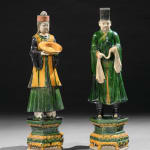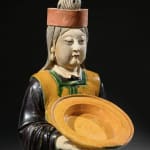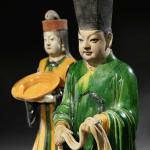A PAIR OF SANCAI GLAZED STONEWARE TOMB FIGURES
Further images
Provenance
A & J. Speelman, London
Private Collection, France
The results of Re.S.Artes thermoluminescence tests, numbers R145324C-2 and R145324C-3 (29-02-2024), confirm the dating of the present figures.
Literature
Jessica Harrison-Hall, Catalogue of Late Yuan and Ming Ceramics in the British Museum (London, 2001), pp.
Albert W. R. Thiel, Chinese Pottery and Stoneware (New York, 1953), pp. 196-7, pls. 88-9
R. L. Hobson, The Wares of the Ming Dynasty (Tokyo, 1962)
An exceptional pair of Ming dynasty sancai glazed stoneware tomb figures of court officials, each vibrantly glazed in cream, amber and emerald and holding offerings
The present figures, dating to the sixteenth century during the Ming Dynasty (1368–1644), evoke the sancai tradition first developed during the Tang Dynasty (618–907). This distinctive glazing technique, meaning “three colors,” combines cream, amber, and emerald hues and was primarily associated with funerary goods, particularly tomb figures. The Tang period, often regarded as a high point in Chinese civilization, saw remarkable artistic achievements and a flourishing cosmopolitan culture, with sancai stoneware among its most celebrated creations.
The production of sancai wares declined following the An Lushan Rebellion (755) and the Tibetan invasion of northern China (763) but was later revived in the late Tang and Liao Dynasty (907–1125). During this period, it was used for life-size luohan temple figures, exemplified by the famous Yixian sculptures now housed in the Metropolitan Museum of Art, the British Museum, the Royal Ontario Museum, and the Penn Museum.
In the Ming Dynasty, sancai experienced a renaissance, particularly in architectural decoration. The glaze was widely applied to roof tiles, such as those in the British Museum and the A.W.R. Thiel Collection. In Chinese belief, rooftops served as symbolic platforms for communication between the mortal and spirit worlds, making sancai-glazed ornaments spiritually significant.
Sancai wares of this quality and period are exceedingly rare. Architectural ornaments from the time often exhibit rougher craftsmanship, and surviving tomb figures tend to be more modest in execution, typically small in scale with simplified modeling. In contrast, the present figures stand out as exceptional examples of Ming sancai artistry, notable not only for their imposing size but also for their expressive detailing, a level of refinement seldom seen in works of this type.
The figures’ monumental scale suggests they were created for an important commission, possibly for a high-ranking patron or a significant religious or funerary context. Comparable Ming sancai figures tend to be far smaller, making these particularly rare survivors. Their bold, high-relief modeling captures movement and naturalism, while their meticulously rendered facial expressions—with finely shaped eyes, delicately arched brows, and subtly contoured lips—convey an exceptional depth of character. Rather than appearing rigid or schematic, as is common in many sancai figures, these exude a remarkable sense of presence and individuality, indicating the hand of a highly skilled artisan.
Moreover, the fluid drapery of their robes, sculpted with a sense of weight and motion, further elevates these figures beyond standard Ming sancai production. The detailing of their garments, from the elegant folds to the interplay of glazed colors, reflects the sophisticated craftsmanship seen in only the finest examples of Ming sancai sculpture.
In outstanding condition and crafted in the grand tradition of Tang figures nearly a thousand years earlier, these figures are among the finest known examples of Ming sancai ware, distinguished by their rare combination of monumental scale, technical mastery, and expressive power.







